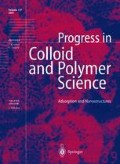Abstract
Photoactive semiconductors such as TiO2 can be applied for wastewater treatment; not only for degradation of organic pollutants, but also for removal of heavy-metal ions. Photoassisted reduction of different, mostly toxic metal ions, such as Hg(II), Pb(II), Bi(III), and Cu(II), has been realized in aqueous systems containing ethanol as a sacrificial electron donor. The efficiency of the photoreduction carried out under the same circumstances is primarily determined by the standard reduction potential of the species containing the metal ion to be removed as demonstrated by the examples of Hg(II), Bi(III), and Pb(II). The relatively lower efficiency for the deposition of Cu may be attributed to a short-circuiting effect. Surfactants of different type also function as potential electron donors in these systems. Negatively charged dodecyl sulfate proved to be much more efficient than ethanol, while cationic cetyltrimethylammonium is rather weak in this respect.
Access this chapter
Tax calculation will be finalised at checkout
Purchases are for personal use only
Preview
Unable to display preview. Download preview PDF.
References
Fox MA (1983) Acc Chem Res 16:314
Hsiao C, Lee C, Ollis DF (1983) J Catal 82:418
Ahmed S, Ollis DF (1984) Sol Energy 32:597
Okamoto K, Yamamoto Y, Tanaka H, Tanaka M (1985) Bull Chem Soc Jpn 58:2015
Ollis DF (1985) Environ Sci Technol 19:480
Matthews RW (1986) Water Res 20:569
Matthews RW (1988) J Catal 111:264
Terzian R, Serpone N, Minero C, Pelizetti E (1991) J Catal 128:352
Heller A, Brock JR (1994) In: Helz GR, Zepp RG, Crosby DG (eds) Aquatic surface photochemistry. Lewia, Boca Raton, pp 427–436
Lea J, Adesina AA (1998) J Photochem Photobiol A 118:111
Curran JS, Domenech J, Jaffrezic-Renault N, Philippe R (1985) J Phys Chem 89:957
Borgarello E, Serpone N, Emo G, Harris R, Pelizetti E (1986) Inorg Chem 25:4499
Domenech J, Munoz J (1987) Electrochim Acta 32:1383
Herrmann J-M, Disdier J, Pichat P (1988) J Catal 113:72
Herrmann J-M, Guillard C, Pichat P (1993) Catal Today 17:7
Serpone N, Ah-You YK, Tran TP, Harris R, Pelizetti E, Hidaka H (1987) Sol Energy 139:491
Prairie MR, Evans LR, Stange BM, Martinez SL (1993) Environ Sci Technol 27:1176
Tennakone K, Wijayantha KGU (1997) J Photochem Photobiol A 113:89
Latimer WL (1952) Oxidation potentials, 2nd edn. Prentice-Hall, Englewood Cliffs
Rajeshwar K, Ibanez JG (1995) J Chem Educ 72:1044
Greenwood NN, Earnshaw A (1984) Chemistry of the elements. Pergamon, Oxford, pp 736, 1409
Bard AJ (ed) (1982) Encyclopedia of electrochemistry of the elements, vol 9, 4th edn. Dekker, New York
Shriver DF, Atkins PW, Langford CH (1992) Anorganische Chemie. VCH, Weinheim, pp 707–722
Tanaka K, Harada K, Murata S (1986) Sol Energy 36:159
Kroschwitz JI, Howe-Grant M (eds) (1994) Kirk-Othmer Encyclopedia of chemical technology, vols 7–8, 4th edn. Wiley, New York
Author information
Authors and Affiliations
Editor information
Rights and permissions
Copyright information
© 2001 Springer-Verlag
About this paper
Cite this paper
Horváth, O., Hegyi, J. (2001). Light-induced reduction of heavy-metal ions on titanium dioxide dispersions. In: Dékány, I. (eds) Adsorption and Nanostructure. Progress in Colloid and Polymer Science, vol 117. Springer, Berlin, Heidelberg. https://doi.org/10.1007/3-540-45405-5_38
Download citation
DOI: https://doi.org/10.1007/3-540-45405-5_38
Published:
Publisher Name: Springer, Berlin, Heidelberg
Print ISBN: 978-3-540-41946-4
Online ISBN: 978-3-540-45405-2
eBook Packages: Springer Book Archive

